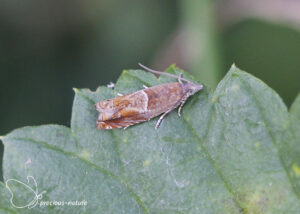The Leafrollers (Tortricidae) are one of the most prominent families within the micro butterflies, with about 10,000 described species worldwide, of which about 1000 are in Europe. The body is usually brown, green, or grey. They owe their name to the caterpillar that rolls up a leaf and lives in it. The rectangular wings appear to be quite wide, and when at rest, they are folded like a roof. The head is covered with rough scales, and the wingspan is about 8 to 40 mm. A characteristic of leafrollers is the fairly wide forewing with a tornus, the angle between the dorsum and the termen. Many species have a wide wing base, which gives the butterfly the so-called ‘bell shape’ in the resting position. The hindwing is at least as wide and sometimes wider than the forewing. The antennae are short, less than 2/3 the length of the forewing. The palps are short, pendulous, protruding, sometimes slightly bent upwards.
In such a large group, it is not surprising that the way of life is very different. The larvae of many species bore into flower heads, seeds, stems, or roots of plants to feed, while others feed on the silk on leaves of their host plant. A number of them are polyphagous, and others are aimed at one or at most a few host plants. Some species have only one generation per year, but most have two or more generations. Some adults fly during the day, others at dusk or night.
There are currently three subfamilies within the leaf roller family for which I have discovered species: the Cnephasiinae, the Olethreutinae and the Tortricinae.




